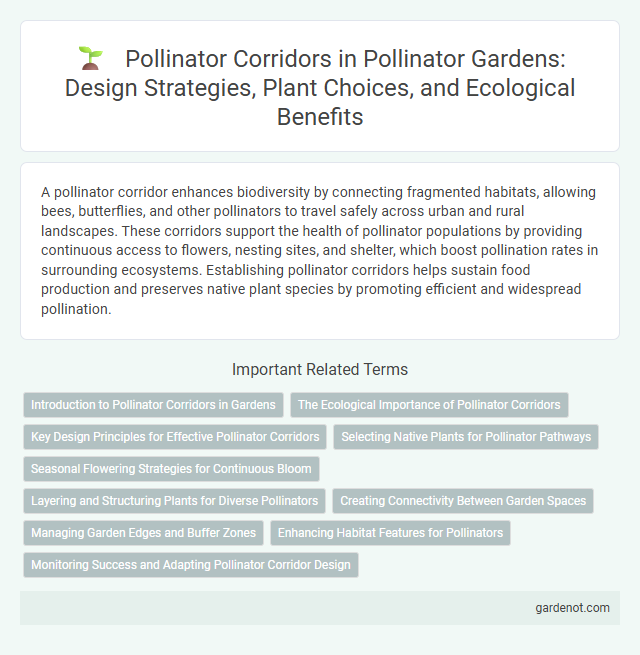A pollinator corridor enhances biodiversity by connecting fragmented habitats, allowing bees, butterflies, and other pollinators to travel safely across urban and rural landscapes. These corridors support the health of pollinator populations by providing continuous access to flowers, nesting sites, and shelter, which boost pollination rates in surrounding ecosystems. Establishing pollinator corridors helps sustain food production and preserves native plant species by promoting efficient and widespread pollination.
Introduction to Pollinator Corridors in Gardens
Pollinator corridors in gardens create interconnected pathways of native flowering plants that support bees, butterflies, and other essential pollinators. These corridors enhance biodiversity, improve pollination efficiency, and contribute to sustainable garden ecosystems. Planting diverse, nectar-rich species along these routes strengthens habitat connectivity and promotes healthy pollinator populations.
The Ecological Importance of Pollinator Corridors
Pollinator corridors serve as essential ecological pathways that connect fragmented habitats, enabling the movement and dispersal of vital pollinator species such as bees, butterflies, and hummingbirds. These corridors enhance plant-pollinator interactions, increase genetic diversity, and improve ecosystem resilience by supporting pollination services critical for food production and biodiversity. Maintaining and restoring pollinator corridors mitigates habitat loss and fragmentation, directly contributing to the conservation of pollinator populations and overall ecosystem health.
Key Design Principles for Effective Pollinator Corridors
Effective pollinator corridors prioritize native plant diversity to provide continuous bloom throughout seasons, supporting a wide range of pollinators such as bees, butterflies, and hummingbirds. The corridor's width and connectivity are crucial for safe pollinator movement, with strips ideally ranging from 30 to 100 feet wide and connecting fragmented habitats. Structural elements like layered vegetation, nesting sites, and water sources enhance habitat quality, fostering pollinator health and biodiversity.
Selecting Native Plants for Pollinator Pathways
Selecting native plants for pollinator corridors enhances habitat connectivity by providing essential nectar and pollen sources tailored to local pollinators' needs. Native species such as milkweed, coneflowers, and goldenrod support diverse pollinator populations including bees, butterflies, and hummingbirds throughout their life cycles. Strategically planting these species in continuous pathways facilitates safe movement and breeding opportunities for pollinators across fragmented landscapes.
Seasonal Flowering Strategies for Continuous Bloom
Pollinator corridors designed with seasonal flowering strategies ensure a continuous bloom throughout spring, summer, and fall, providing consistent nectar and pollen sources for bees, butterflies, and hummingbirds. Implementing a diverse mix of native perennials, shrubs, and annuals tailored to local climate ensures staggered flowering periods, supporting pollinator health and biodiversity. Strategic plant selection and spatial arrangement in the corridor promote habitat connectivity and enhance pollination services across urban and agricultural landscapes.
Layering and Structuring Plants for Diverse Pollinators
Creating a pollinator corridor requires strategic layering and structuring of plants to support a wide range of pollinators like bees, butterflies, and hummingbirds. Incorporating ground covers, mid-height shrubs, and tall flowering plants ensures continuous bloom periods and diverse nectar sources. This vertical and spatial plant diversity enhances habitat connectivity, promoting efficient pollination and biodiversity in urban and rural landscapes.
Creating Connectivity Between Garden Spaces
Establishing a pollinator corridor enhances biodiversity by connecting isolated garden spaces with native flowering plants and nesting habitats that support bees, butterflies, and other pollinators. Continuous corridors facilitate safe movement and genetic exchange among pollinator populations, improving ecosystem resilience and plant pollination rates. Strategic placement of habitat patches within urban and suburban landscapes promotes ecological connectivity critical for sustaining pollinator communities.
Managing Garden Edges and Buffer Zones
Managing garden edges and buffer zones enhances pollinator corridors by providing diverse floral resources and shelter, crucial for sustaining pollinator populations. Incorporating native flowering plants and shrubs in these transitional areas creates a continuous habitat that supports foraging, nesting, and migratory movements of bees, butterflies, and other pollinators. Effective management practices minimize pesticide use and maintain structural complexity, promoting ecological connectivity and resilience across urban and rural landscapes.
Enhancing Habitat Features for Pollinators
Strategically designed pollinator corridors create continuous habitats that support diverse pollinator species by connecting fragmented green spaces. Incorporating native flowering plants, nesting sites, and water sources within these corridors enhances foraging opportunities and reproductive success. These habitat features increase pollinator biodiversity and improve ecosystem resilience across urban and rural landscapes.
Monitoring Success and Adapting Pollinator Corridor Design
Monitoring success in a pollinator corridor involves systematic surveys of pollinator species diversity, abundance, and habitat utilization to assess corridor effectiveness. Adaptive management includes modifying plant compositions, spatial arrangements, and habitat connectivity based on monitoring data to enhance pollinator movement and foraging. Employing technologies like remote sensing and citizen science ensures dynamic, data-driven improvements to corridor design and ecosystem services.
Pollinator corridor Infographic

 gardenot.com
gardenot.com